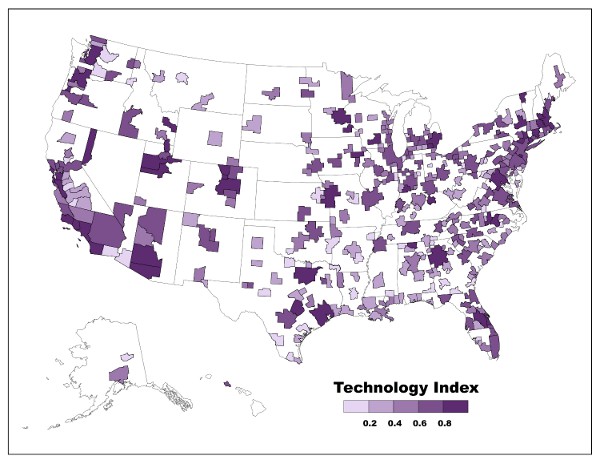For years, Silicon Valley – home to companies like Intel, Apple, Google and Facebook – has been America’s (and the world’s) undisputed high-tech center. But recently, urban centers from San Francisco, home to Twitter, to New York City – which has surpassed greater Boston to become the nation’s second leading center for venture capital investment – have become high-tech hubs as well. This is happening in Europe, too—London’s Silicon Roundabout and Berlin are both emerging as technology centers.
Which cities and metros are America’s high-tech leaders?
 (Click the map for a larger image)
(Click the map for a larger image)
The map above shows how America’s metros stack up on the Technology Index my Martin Prosperity Institute research team and I developed for my just-published Rise of the Creative Class, Revisited. The index combines a measure of the concentration of high-tech companies (based on the Milken Institute’s Tech-Pole Index) and two measures of regional innovation, patents per capita and average annual patent growth. The table below lists the top 20 U.S. metros.
Seattle takes first place, besting Silicon Valley, which ranked on top on the original 2002 version of the index. This is not as surprising as it might seem. Seattle is, after all, home to Microsoft, Amazon, and many other high-tech powerhouses.
Silicon Valley (that is the San Jose metro) takes second, followed by the greater San Francisco metro, which has gained ground as large numbers of key high-tech talent and firms have come to prefer more urban locations, such as Twitter, Zynga and Salesforce.com.
Portland, Oregon, is fourth and Austin (with its large tech cluster) is fifth, followed by Raleigh, San Diego, and then Durham. Greater Boston (home to MIT and Harvard as well as the famed Route 128 high-tech cluster) and Boulder, Colorado (which Business Week dubbed the nation’s best place for startups round out the top 10.
Rounding out the top 20 are Burlington, Vermont (home to the University of Vermont); Tucson, Arizona (University of Arizona); Provo, Utah (Brigham Young University); Corvallis, Oregon (home to Oregon State University, a major Hewlett Packard printer prototyping facility and numerous bio tech companies); Huntsville, Alabama (NASA‘s Marshall Space Flight Center and the United States Army Aviation and Missile Command as well as numerous high-tech electronics companies); Poughkeepsie, New York (home to IBM); Minneapolis–St. Paul (University of Minnesota); Madison, Wisconsin (with a budding tech hub around the University of Wisconsin); Oxnard–Thousand Oaks, California; and Manchester, New Hampshire (near Boston’s Route 128).
There are some conspicuous absences from the list. Despite the great success of New York City — in particular lower Manhattan — in generating high-tech firms and attracting high-tech companies, the New York metro does not make the list. Nor does Washington, D.C. despite its concentration of high-tech districts in Northern Virginia and federal research facilities in Montgomery County, Maryland and Northern Virginia.
While technology is an important driver of economic growth and development, it needs to be part of a broader social and cultural ecosystem before it can generate real prosperity. There is considerable overlap between the Technology Index and the Creative Class, which makes up more than 35 percent of the workforce in 14 of the top 20 Technology Index metros, and exceeds 40 percent in six of them.
Technology is the first of my 3Ts of economic development, the other two being Talent and Tolerance. Each one on its own is a necessary but insufficient condition for growth. For real innovation and sustained economic growth, a community must offer all three. That means that some cities and metros may still fail to grow at a high rate, despite their deep reservoirs of technology and world-class universities, if they lag behind on the other two T’s – if they are exporting talent or are relatively closed to outsiders. Conversely, the interactive effect of the 3T’s helps explain why some cities and metros may fail to grow at a substantial rate, even though they are lifestyle meccas: they lack the required technology base.
At the end of the day, the most successful cities and metros are more than just technology leaders; they put all of the 3T’s together.
Photo credit: pzAxe /Shutterstock
